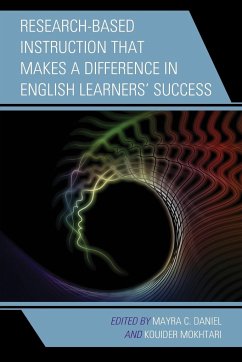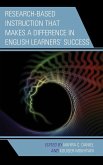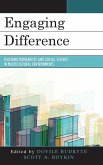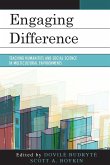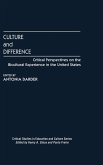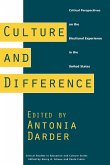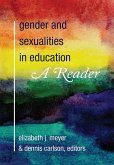Research-Based Instruction that Makes a Difference in English Learners' Success
Herausgeber: Daniel, Mayra C.; Mokhtari, Kouider
Research-Based Instruction that Makes a Difference in English Learners' Success
Herausgeber: Daniel, Mayra C.; Mokhtari, Kouider
- Broschiertes Buch
- Merkliste
- Auf die Merkliste
- Bewerten Bewerten
- Teilen
- Produkt teilen
- Produkterinnerung
- Produkterinnerung
The content of the book integrates new and emerging research and policy insights that inform effective teaching of ELs across the disciplines. The chapters in this book will in ways to give teachers the tools they need to improve the quality of instruction in classrooms with ELs in grades K-12 both in the United States and around the world.
Andere Kunden interessierten sich auch für
![Research-Based Instruction that Makes a Difference in English Learners' Success Research-Based Instruction that Makes a Difference in English Learners' Success]() Research-Based Instruction that Makes a Difference in English Learners' Success113,99 €
Research-Based Instruction that Makes a Difference in English Learners' Success113,99 €![Engaging Difference Engaging Difference]() Engaging Difference53,99 €
Engaging Difference53,99 €![Engaging Difference Engaging Difference]() Engaging Difference30,99 €
Engaging Difference30,99 €![Culture and Difference Culture and Difference]() Culture and Difference87,99 €
Culture and Difference87,99 €![Culture and Difference Culture and Difference]() Culture and Difference44,99 €
Culture and Difference44,99 €![Gender and Sexualities in Education Gender and Sexualities in Education]() Gender and Sexualities in Education206,70 €
Gender and Sexualities in Education206,70 €![Making a difference? Making a difference?]() Ruth TownsleyMaking a difference?26,99 €
Ruth TownsleyMaking a difference?26,99 €-
-
-
The content of the book integrates new and emerging research and policy insights that inform effective teaching of ELs across the disciplines. The chapters in this book will in ways to give teachers the tools they need to improve the quality of instruction in classrooms with ELs in grades K-12 both in the United States and around the world.
Produktdetails
- Produktdetails
- Verlag: Rowman & Littlefield Publishers
- Seitenzahl: 268
- Erscheinungstermin: 11. Dezember 2015
- Englisch
- Abmessung: 229mm x 152mm x 16mm
- Gewicht: 440g
- ISBN-13: 9781475818666
- ISBN-10: 1475818661
- Artikelnr.: 42605996
- Herstellerkennzeichnung
- Libri GmbH
- Europaallee 1
- 36244 Bad Hersfeld
- gpsr@libri.de
- Verlag: Rowman & Littlefield Publishers
- Seitenzahl: 268
- Erscheinungstermin: 11. Dezember 2015
- Englisch
- Abmessung: 229mm x 152mm x 16mm
- Gewicht: 440g
- ISBN-13: 9781475818666
- ISBN-10: 1475818661
- Artikelnr.: 42605996
- Herstellerkennzeichnung
- Libri GmbH
- Europaallee 1
- 36244 Bad Hersfeld
- gpsr@libri.de
Dr. Mayra C. Daniel, associate professor in the Department of Literacy and Elementary Education at Northern Illinois University, serves as the Bilingual ESL Coordinator for NIU's College of Education. Her research focuses on preparing teachers to work with bilingual and multilingual populations in the United States and in Latin America. Prior to her work with teachers in post-graduate programs, she worked to help learners (at levels K-12) from diverse linguistic and cultural backgrounds to transition and adapt to the cultural norms of life in schooling within rural communities in the state of Illinois. Kouider Mokhtari is the Anderson-Vukelja-Wright Endowed Professor, Literacy Education, at the University of Texas at Tyler, Texas, where he engages in research, teaching, and service initiatives aimed at advancing literacy instruction and increasing students' literacy achievement outcomes. His research focuses on the acquisition of language and literacy by first and second language learners, with particular emphasis on children, adolescents, and adults who can read but have difficulties understanding what they read. Kouider's research has been featured in various literacy research and practice journals. His book Preparing Every Teacher to Reach English Learners (Harvard University Press) was presented the 2013 American Association of Colleges For Teacher Education (AACTE) Outstanding Book Award. He was also the recipient of the 2014 International Reading Association John C. Manning Public School Service Award.
Introduction: Research, Policy, and Practice Insights to Support the
Teaching of English Learners in Mainstream Classrooms
Kouider Mokhtari and Myra Daniel
Part I: Supporting English Learners' language and Literacy Development
Across the Disciplines
Chapter 1. Enhancing English Learners' Access to Disciplinary Texts Through
Close Reading Practices
Zhihui Fang, Suzanne C. Chapman, University of Florida
Chapter 2. High Expectations: Increasing Productivity and Complexity in
English Learner (EL) Writing
Kathleen A. J. Mohr, Sylvia Read, Alayne Leavitt, Utah State University
Chapter 3. A Middle School Mathematics Workshop for Multilingual
Classrooms: Lessons Learned From A Highly Effective Teacher
Mayra C. Daniel, Northern Illinois University, Billy Hueramo, Littlejohn
Elementary School
Chapter 4. Using Art and Literature to Enhance Critical Thinking and
Vocabulary Development for English Learners
Chris Carger, Northern Illinois University
Chapter 5. The Case for Young Adult Literature: Using Narratives in the EL
Classroom
Melanie D. Koss, Northern Illinois University
Part II: Using Assessment Data To Document Student Performance And Inform
Instruction
Chapter 6. Using Metacognitive Assessments to Identify Students' Reading
Comprehension Strengths and Needs
Kouider Mokhtari, The University of Texas at Tyler
Chapter 7. Using Classroom Assessment of Language Levels (CALL) to Address
Common Core Standards-based Instruction with English Learners, K-8
Paul Boyd-Batstone, California State University
Part III: Supporting Students Literacy Development In Digital Spaces
Chapter 8. Digital Literacies for English Learners: Theory and Practice
Ian O'Byrne, University of New Haven, Martha Castañeda, Miami University
Chapter 9. Integrating Social Media into ELA Curriculum: Towards English
Learners' Academic Literacy Development
Dong-shin Shin, Northern Illinois University
Part VI: Using Key Understandings About Language and Literacy to Support
Instruction for English Learners
Chapter 10. Insights Gleaned from Research Syntheses About Teaching English
Learners
John Evar Strid, Northern Illinois University
Chapter 11. Addressing the Reading Comprehension Challenges of English
Learners in K-12 Classrooms Using Research-Based Practices
Fabiola P. Ehlers-Zavala, Colorado State University
Chapter 12. Socrates Returns to the Classroom
Joan Wink, California State University, Kerry Britton, Hill City Middle
School,
Dee Hawksworth, Oakdale Junior High School, Tammy Mc Morrow, Indian Creek
Elementary School, Debra Schneider, Tracy Unified School District, Chyllis
Scott, University of Nevada, Ruthie Wienk, South Dakota State University,
Dawn Wink, Santa Fe Community College
Chapter 13. Mainstream Literacy Teachers in Multilingual and Transnational
Learning Communities: Making a Case for Transliteracy
David Schwarzer, Montclair State University
Teaching of English Learners in Mainstream Classrooms
Kouider Mokhtari and Myra Daniel
Part I: Supporting English Learners' language and Literacy Development
Across the Disciplines
Chapter 1. Enhancing English Learners' Access to Disciplinary Texts Through
Close Reading Practices
Zhihui Fang, Suzanne C. Chapman, University of Florida
Chapter 2. High Expectations: Increasing Productivity and Complexity in
English Learner (EL) Writing
Kathleen A. J. Mohr, Sylvia Read, Alayne Leavitt, Utah State University
Chapter 3. A Middle School Mathematics Workshop for Multilingual
Classrooms: Lessons Learned From A Highly Effective Teacher
Mayra C. Daniel, Northern Illinois University, Billy Hueramo, Littlejohn
Elementary School
Chapter 4. Using Art and Literature to Enhance Critical Thinking and
Vocabulary Development for English Learners
Chris Carger, Northern Illinois University
Chapter 5. The Case for Young Adult Literature: Using Narratives in the EL
Classroom
Melanie D. Koss, Northern Illinois University
Part II: Using Assessment Data To Document Student Performance And Inform
Instruction
Chapter 6. Using Metacognitive Assessments to Identify Students' Reading
Comprehension Strengths and Needs
Kouider Mokhtari, The University of Texas at Tyler
Chapter 7. Using Classroom Assessment of Language Levels (CALL) to Address
Common Core Standards-based Instruction with English Learners, K-8
Paul Boyd-Batstone, California State University
Part III: Supporting Students Literacy Development In Digital Spaces
Chapter 8. Digital Literacies for English Learners: Theory and Practice
Ian O'Byrne, University of New Haven, Martha Castañeda, Miami University
Chapter 9. Integrating Social Media into ELA Curriculum: Towards English
Learners' Academic Literacy Development
Dong-shin Shin, Northern Illinois University
Part VI: Using Key Understandings About Language and Literacy to Support
Instruction for English Learners
Chapter 10. Insights Gleaned from Research Syntheses About Teaching English
Learners
John Evar Strid, Northern Illinois University
Chapter 11. Addressing the Reading Comprehension Challenges of English
Learners in K-12 Classrooms Using Research-Based Practices
Fabiola P. Ehlers-Zavala, Colorado State University
Chapter 12. Socrates Returns to the Classroom
Joan Wink, California State University, Kerry Britton, Hill City Middle
School,
Dee Hawksworth, Oakdale Junior High School, Tammy Mc Morrow, Indian Creek
Elementary School, Debra Schneider, Tracy Unified School District, Chyllis
Scott, University of Nevada, Ruthie Wienk, South Dakota State University,
Dawn Wink, Santa Fe Community College
Chapter 13. Mainstream Literacy Teachers in Multilingual and Transnational
Learning Communities: Making a Case for Transliteracy
David Schwarzer, Montclair State University
Introduction: Research, Policy, and Practice Insights to Support the
Teaching of English Learners in Mainstream Classrooms
Kouider Mokhtari and Myra Daniel
Part I: Supporting English Learners' language and Literacy Development
Across the Disciplines
Chapter 1. Enhancing English Learners' Access to Disciplinary Texts Through
Close Reading Practices
Zhihui Fang, Suzanne C. Chapman, University of Florida
Chapter 2. High Expectations: Increasing Productivity and Complexity in
English Learner (EL) Writing
Kathleen A. J. Mohr, Sylvia Read, Alayne Leavitt, Utah State University
Chapter 3. A Middle School Mathematics Workshop for Multilingual
Classrooms: Lessons Learned From A Highly Effective Teacher
Mayra C. Daniel, Northern Illinois University, Billy Hueramo, Littlejohn
Elementary School
Chapter 4. Using Art and Literature to Enhance Critical Thinking and
Vocabulary Development for English Learners
Chris Carger, Northern Illinois University
Chapter 5. The Case for Young Adult Literature: Using Narratives in the EL
Classroom
Melanie D. Koss, Northern Illinois University
Part II: Using Assessment Data To Document Student Performance And Inform
Instruction
Chapter 6. Using Metacognitive Assessments to Identify Students' Reading
Comprehension Strengths and Needs
Kouider Mokhtari, The University of Texas at Tyler
Chapter 7. Using Classroom Assessment of Language Levels (CALL) to Address
Common Core Standards-based Instruction with English Learners, K-8
Paul Boyd-Batstone, California State University
Part III: Supporting Students Literacy Development In Digital Spaces
Chapter 8. Digital Literacies for English Learners: Theory and Practice
Ian O'Byrne, University of New Haven, Martha Castañeda, Miami University
Chapter 9. Integrating Social Media into ELA Curriculum: Towards English
Learners' Academic Literacy Development
Dong-shin Shin, Northern Illinois University
Part VI: Using Key Understandings About Language and Literacy to Support
Instruction for English Learners
Chapter 10. Insights Gleaned from Research Syntheses About Teaching English
Learners
John Evar Strid, Northern Illinois University
Chapter 11. Addressing the Reading Comprehension Challenges of English
Learners in K-12 Classrooms Using Research-Based Practices
Fabiola P. Ehlers-Zavala, Colorado State University
Chapter 12. Socrates Returns to the Classroom
Joan Wink, California State University, Kerry Britton, Hill City Middle
School,
Dee Hawksworth, Oakdale Junior High School, Tammy Mc Morrow, Indian Creek
Elementary School, Debra Schneider, Tracy Unified School District, Chyllis
Scott, University of Nevada, Ruthie Wienk, South Dakota State University,
Dawn Wink, Santa Fe Community College
Chapter 13. Mainstream Literacy Teachers in Multilingual and Transnational
Learning Communities: Making a Case for Transliteracy
David Schwarzer, Montclair State University
Teaching of English Learners in Mainstream Classrooms
Kouider Mokhtari and Myra Daniel
Part I: Supporting English Learners' language and Literacy Development
Across the Disciplines
Chapter 1. Enhancing English Learners' Access to Disciplinary Texts Through
Close Reading Practices
Zhihui Fang, Suzanne C. Chapman, University of Florida
Chapter 2. High Expectations: Increasing Productivity and Complexity in
English Learner (EL) Writing
Kathleen A. J. Mohr, Sylvia Read, Alayne Leavitt, Utah State University
Chapter 3. A Middle School Mathematics Workshop for Multilingual
Classrooms: Lessons Learned From A Highly Effective Teacher
Mayra C. Daniel, Northern Illinois University, Billy Hueramo, Littlejohn
Elementary School
Chapter 4. Using Art and Literature to Enhance Critical Thinking and
Vocabulary Development for English Learners
Chris Carger, Northern Illinois University
Chapter 5. The Case for Young Adult Literature: Using Narratives in the EL
Classroom
Melanie D. Koss, Northern Illinois University
Part II: Using Assessment Data To Document Student Performance And Inform
Instruction
Chapter 6. Using Metacognitive Assessments to Identify Students' Reading
Comprehension Strengths and Needs
Kouider Mokhtari, The University of Texas at Tyler
Chapter 7. Using Classroom Assessment of Language Levels (CALL) to Address
Common Core Standards-based Instruction with English Learners, K-8
Paul Boyd-Batstone, California State University
Part III: Supporting Students Literacy Development In Digital Spaces
Chapter 8. Digital Literacies for English Learners: Theory and Practice
Ian O'Byrne, University of New Haven, Martha Castañeda, Miami University
Chapter 9. Integrating Social Media into ELA Curriculum: Towards English
Learners' Academic Literacy Development
Dong-shin Shin, Northern Illinois University
Part VI: Using Key Understandings About Language and Literacy to Support
Instruction for English Learners
Chapter 10. Insights Gleaned from Research Syntheses About Teaching English
Learners
John Evar Strid, Northern Illinois University
Chapter 11. Addressing the Reading Comprehension Challenges of English
Learners in K-12 Classrooms Using Research-Based Practices
Fabiola P. Ehlers-Zavala, Colorado State University
Chapter 12. Socrates Returns to the Classroom
Joan Wink, California State University, Kerry Britton, Hill City Middle
School,
Dee Hawksworth, Oakdale Junior High School, Tammy Mc Morrow, Indian Creek
Elementary School, Debra Schneider, Tracy Unified School District, Chyllis
Scott, University of Nevada, Ruthie Wienk, South Dakota State University,
Dawn Wink, Santa Fe Community College
Chapter 13. Mainstream Literacy Teachers in Multilingual and Transnational
Learning Communities: Making a Case for Transliteracy
David Schwarzer, Montclair State University

